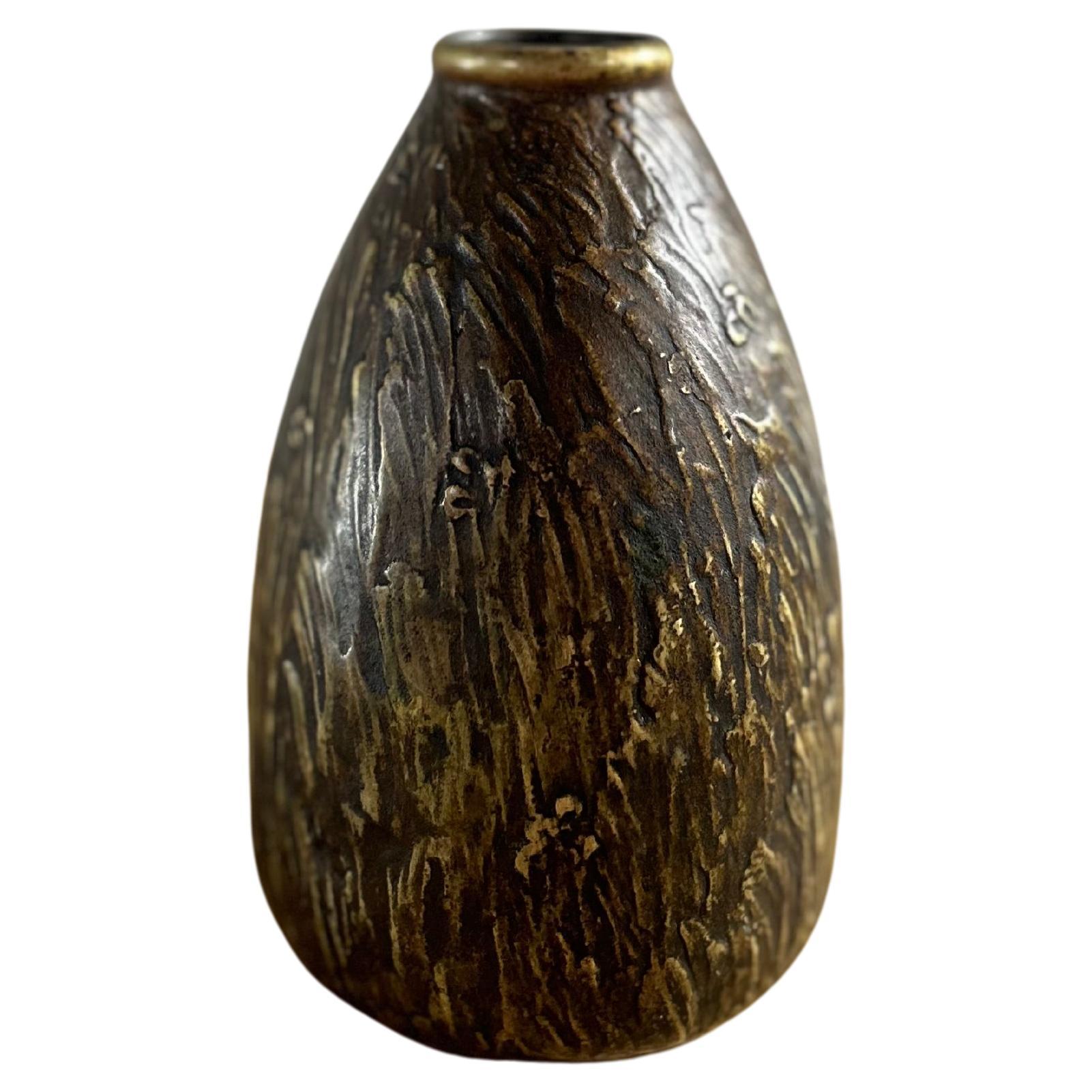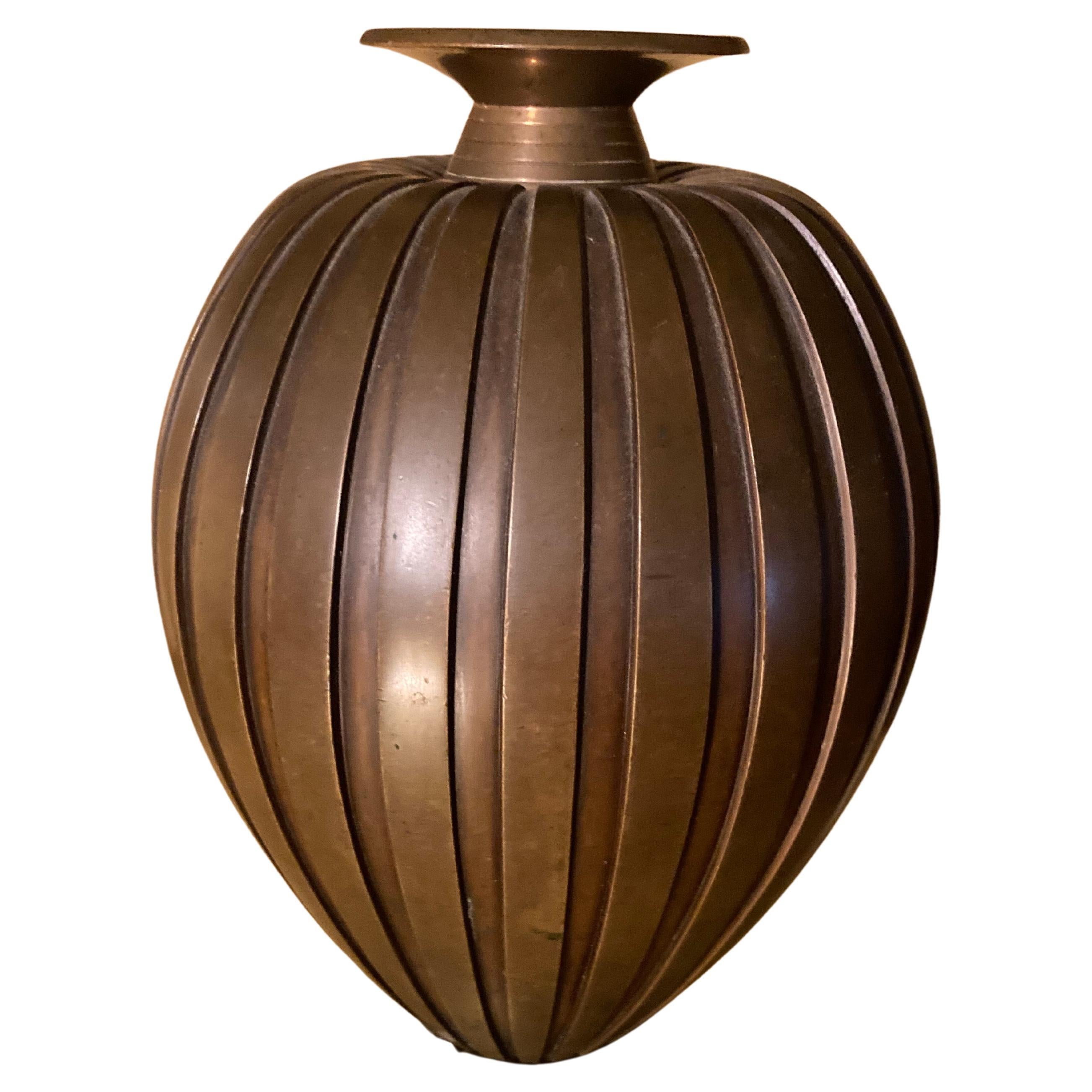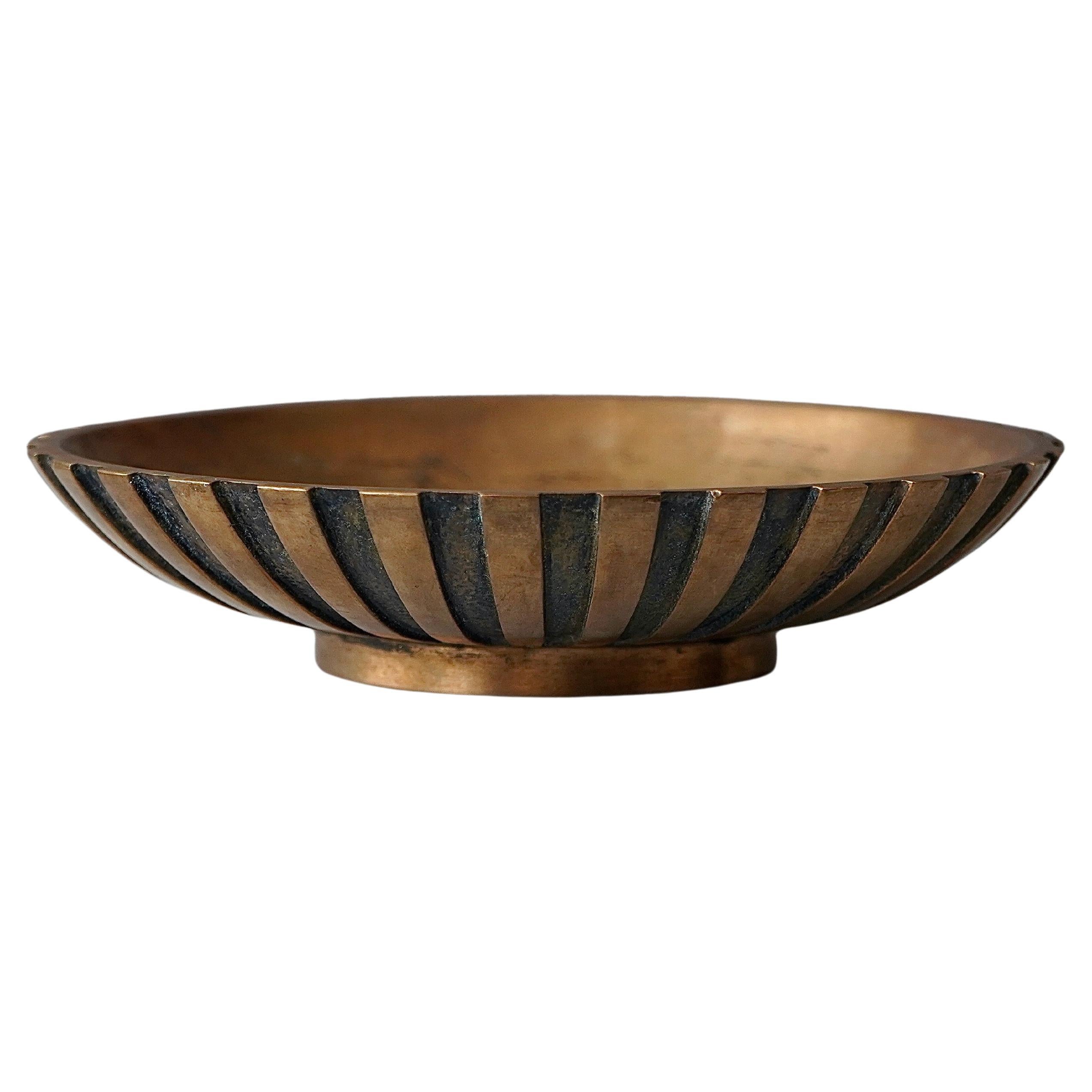Items Similar to Evan Jensen Bronze Dish, Denmark, 1930s
Want more images or videos?
Request additional images or videos from the seller
1 of 10
Evan Jensen Bronze Dish, Denmark, 1930s
About the Item
Bronze Art deco dish/charger by Danish artist Evan Jensen from the 1930's in a beautiful original condition, the dish is signed Evan Jensen Copenhagen Bronze and has model number 320.
The dish has a very decorative image of a deer on the front.
The dish is the perfect dish to have standing as a piece of art but can also be used as a bowl to store stuff like fruit or nuts or whatever else you could think of.
Art Deco, short for the French Arts Décoratifs, and sometimes just called Deco, is a style of visual arts, architecture, and product design, that first appeared in France in the 1910s (just before World War I), and flourished in the United States and Europe during the 1920s and 1930s. Through styling and design of the exterior and interior of anything from large structures to small objects, including how people look (clothing, fashion and jewelry), Art Deco has influenced bridges, buildings (from skyscrapers to cinemas), ships, ocean liners, trains, cars, trucks, buses, furniture, and everyday objects like radios and vacuum cleaners.
It got its name after the 1925 Exposition internationale des arts décoratifs et industriels modernes (International Exhibition of Modern Decorative and Industrial Arts) held in Paris.
Art Deco combined modern styles with fine craftsmanship and rich materials. During its heyday, it represented luxury, glamour, exuberance, and faith in social and technological progress.
From its outset, Art Deco was influenced by the bold geometric forms of Cubism and the Vienna Secession; the bright colours of Fauvism and of the Ballets Russes; the updated craftsmanship of the furniture of the eras of Louis XVI and Louis Philippe I; and the exoticized styles of China, Japan, India, Persia, ancient Egypt and Maya art. It featured rare and expensive materials, such as ebony and ivory, and exquisite craftsmanship. The Empire State Building, Chrysler Building, and other skyscrapers of New York City built during the 1920s and 1930s are monuments to the style.
In the 1930s, during the Great Depression, Art Deco became more subdued. New materials arrived, including chrome plating, stainless steel and plastic. A sleeker form of the style, called Streamline Moderne, appeared in the 1930s, featuring curving forms and smooth, polished surfaces. Art Deco is one of the first truly international styles, but its dominance ended with the beginning of World War II and the rise of the strictly functional and unadorned styles of modern architecture and the International Style of architecture that followed.
This dish is the perfect detail for any interior from the modern Wabi Sabi style interior to a more traditional Scandinavian to a Art Deco interior, it will add a decorative element to the interior and will be a great conversation piece.
- Creator:Evan Jensen (Maker, Designer)
- Dimensions:Height: 1.58 in (4 cm)Diameter: 8.47 in (21.5 cm)
- Style:Scandinavian Modern (Of the Period)
- Materials and Techniques:Bronze,Patinated
- Place of Origin:
- Period:
- Date of Manufacture:1930s
- Condition:Wear consistent with age and use.
- Seller Location:Valby, DK
- Reference Number:1stDibs: LU6559233703312
About the Seller
5.0
Vetted Seller
These experienced sellers undergo a comprehensive evaluation by our team of in-house experts.
1stDibs seller since 2022
25 sales on 1stDibs
Typical response time: <1 hour
- ShippingRetrieving quote...Ships From: Valby, Denmark
- Return PolicyA return for this item may be initiated within 2 days of delivery.
More From This SellerView All
- Evan Jensen Bronze Vase, Denmark, 1930sBy Evan JensenLocated in Valby, 84Rare bronze vase attributed Evan Jensen made in Denmark in the 1930s. The vase is made by a unknown danish caster called Antika but is a typical Evan Jensen shaped vase and has typical Evan Jensen detail. The vase is in good condition with a beautiful original patina. Art Deco, short for the French Arts Décoratifs, and sometimes just called Deco, is a style of visual arts, architecture, and product design, that first appeared in France in the 1910s (just before World War I), and flourished in the United States and Europe during the 1920s and 1930s. Through styling and design of the exterior and interior of anything from large structures to small objects, including how people look (clothing, fashion and jewelry), Art Deco has influenced bridges, buildings (from skyscrapers to cinemas), ships, ocean liners, trains, cars, trucks, buses, furniture, and everyday objects like radios and vacuum cleaners. It got its name after the 1925 Exposition internationale des arts décoratifs et industriels modernes (International Exhibition of Modern Decorative and Industrial Arts) held in Paris. Art Deco combined modern styles with fine craftsmanship and rich materials. During its heyday, it represented luxury, glamour, exuberance, and faith in social and technological progress. From its outset, Art Deco was influenced by the bold geometric forms of Cubism and the Vienna Secession; the bright colours of Fauvism and of the Ballets Russes; the updated craftsmanship of the furniture of the eras of Louis XVI and Louis Philippe I; and the exoticized styles of China, Japan, India, Persia, ancient Egypt and Maya art. It featured rare and expensive materials, such as ebony and ivory, and exquisite craftsmanship. The Empire State Building, Chrysler Building, and other skyscrapers of New York City built during the 1920s and 1930s are monuments to the style. In the 1930s, during the Great Depression, Art Deco became more subdued. New materials arrived, including chrome plating, stainless steel and plastic. A sleeker form of the style, called Streamline Moderne, appeared in the 1930s, featuring curving forms and smooth, polished surfaces. Art Deco is one of the first truly international styles, but its dominance ended with the beginning of World War II and the rise of the strictly functional and unadorned styles of modern architecture and the International Style of architecture that followed. This vase is the perfect detail for any interior from the modern Wabi Sabi style...Category
Vintage 1920s Danish Scandinavian Modern Vases
MaterialsBronze
- Evan Jensen Bronze Vase, Denmark, 1930sBy Evan JensenLocated in Valby, 84Evan Jensen bronze art deco vase made by Danish artist Evan Jensen in the 1930s. The vase is in a beautiful original condition and is signed Evan Jensen København Bronze and has model number 155A. The vase is a beautiful decorative element to any interior and the structure of the vase is fantastic with lots of details which will give you endless hours of enjoyment looking at. Art Deco, short for the French Arts Décoratifs, and sometimes just called Deco, is a style of visual arts, architecture, and product design, that first appeared in France in the 1910s (just before World War I), and flourished in the United States and Europe during the 1920s and 1930s. Through styling and design of the exterior and interior of anything from large structures to small objects, including how people look (clothing, fashion and jewelry), Art Deco has influenced bridges, buildings (from skyscrapers to cinemas), ships...Category
Vintage 1930s Danish Scandinavian Modern Vases
MaterialsBronze
- Evan Jensen Bronze Vase, Denmark 1930’sBy Evan JensenLocated in Valby, 84bronze vase by Evan Jensen, crafted in Denmark during the 1930s. Renowned for his mastery of bronze work and innovative designs, Jensen’s pieces are highly sought after by collectors and enthusiasts alike. This stunning vase showcases Jensen’s exceptional craftsmanship and artistic vision, with its graceful silhouette and intricate detailing. The rich patina of the bronze adds depth and character to the piece, while the organic forms and geometric accents create a harmonious balance of tradition and modernity. Standing as a testament to the golden age of Danish design, this vase embodies the principles of Scandinavian craftsmanship and aesthetic refinement. Its versatile design allows it to effortlessly complement a variety of interior styles, from Art Deco to contemporary. Whether displayed as a standalone statement piece or adorned with fresh flowers, this Evan Jensen bronze...Category
Vintage 1930s Danish Scandinavian Modern Vases
MaterialsBronze
- Just Andersen Art Deco Light Bronze Dish Denmark 1930sBy Just AndersenLocated in Valby, 84Just Andersen Art Deco dish in beautiful patinaed light bronze made in Denmark in the 1930's. This dish is the perfect piece as a decorative element but can also be used as a fruit or nut bowl or whatever else you could think of. The dish is signed Just Andersen LB 1734. Art Deco, short for the French Arts Décoratifs, and sometimes just called Deco, is a style of visual arts, architecture, and product design, that first appeared in France in the 1910s (just before World War I), and flourished in the United States and Europe during the 1920s and 1930s. Through styling and design of the exterior and interior of anything from large structures to small objects, including how people look (clothing, fashion and jewelry), Art Deco has influenced bridges, buildings (from skyscrapers to cinemas), ships...Category
Vintage 1930s Danish Scandinavian Modern Decorative Dishes and Vide-Poche
MaterialsBronze
- Agentor Art Deco Bronze tray Denmark 1930sLocated in Valby, 84Beautiful patinaed Art Deco Bronze dish by danish manufacture Agentor from the 1930's. The Dish has the motive of a woman running with her hunting dog next to her. This dish is the perfect piece as a decorative element but can also be used as a fruit or nut bowl or whatever else you could think of. The dish is signed Agentor Bronce number 47. Art Deco, short for the French Arts Décoratifs, and sometimes just called Deco, is a style of visual arts, architecture, and product design, that first appeared in France in the 1910s (just before World War I), and flourished in the United States and Europe during the 1920s and 1930s. Through styling and design of the exterior and interior of anything from large structures to small objects, including how people look (clothing, fashion and jewelry), Art Deco has influenced bridges, buildings (from skyscrapers to cinemas), ships, ocean liners, trains, cars, trucks, buses, furniture, and everyday objects like radios and vacuum cleaners. It got its name after the 1925 Exposition internationale des arts décoratifs et industriels modernes (International Exhibition of Modern Decorative and Industrial Arts) held in Paris. Art Deco combined modern styles with fine craftsmanship and rich materials. During its heyday, it represented luxury, glamour, exuberance, and faith in social and technological progress. From its outset, Art Deco was influenced by the bold geometric forms of Cubism and the Vienna Secession; the bright colours of Fauvism and of the Ballets Russes; the updated craftsmanship of the furniture of the eras of Louis XVI and Louis Philippe I; and the exoticized styles of China, Japan, India, Persia, ancient Egypt and Maya art. It featured rare and expensive materials, such as ebony and ivory, and exquisite craftsmanship. The Empire State Building, Chrysler Building, and other skyscrapers of New York City built during the 1920s and 1930s are monuments to the style. In the 1930s, during the Great Depression, Art Deco became more subdued. New materials arrived, including chrome plating, stainless steel and plastic. A sleeker form of the style, called Streamline Moderne, appeared in the 1930s, featuring curving forms and smooth, polished surfaces. Art Deco is one of the first truly international styles, but its dominance ended with the beginning of World War II and the rise of the strictly functional and unadorned styles of modern architecture and the International Style of architecture that followed. This dish are the perfect detail for any interior from the modern Wabi Sabi style...Category
Vintage 1930s Danish Art Deco Decorative Dishes and Vide-Poche
MaterialsBronze
- Just Andersen Art Deco Solid Bronze bowl model B161, Denmark 1930’sBy Just AndersenLocated in Valby, 84Discover a piece of Danish design history with this exquisite vintage solid bronze bowl, model B161, crafted by the iconic artist Just Andersen in the 1930s. This stunning bowl epito...Category
Vintage 1930s Danish Scandinavian Modern Decorative Bowls
MaterialsBronze
You May Also Like
- Elegant Art Déco Bronze Vase by Evan Jensen, Denmark, 1930sBy Evan JensenLocated in Köln, NWAn elegant bronze vase by Evan Jensen, 1930s. Denmark. The vase is marked and numbered in the bottom. Removable cylinder. It is not so much a vase as a noble decorative Design object...Category
Vintage 1930s Danish Art Deco Vases
MaterialsBronze
- Danish Designer, Decorative Dish, Bronze, Denmark 1930sLocated in High Point, NCA small decorative bronze dish, designed and produced in Denmark, 1930s.Category
Vintage 1930s Danish Scandinavian Modern Decorative Dishes and Vide-Poche
MaterialsBronze
- Small Tinos Bronze Bowl, Art Deco, Denmark, 1930sBy Evan Jensen, Sune Bäckström, Tinos, GAB Guldsmedsaktiebolaget, Just AndersenLocated in Malmö, SEA small but beautiful art deco bronze bowl with amazing patina. Made by Tinos in Denmark, 1930s. Great condition. Stamped 'TINOS', 'BRONCE' and 'MADE IN DENMARK'.Category
Mid-20th Century Danish Scandinavian Modern Decorative Bowls
MaterialsBronze
- Bronze Candleholder by Evan JensenBy Evan JensenLocated in Long Island City, NYEvan Jensen, bronze candlestick in Art Deco style. Sweden. Designed circa 1930. Stamped on the bottom: Evan Jensen Kobenhavn Bronze 320. Measures: Height 16.5 cm, diameter 12.5 cm.Category
Vintage 1930s Swedish Scandinavian Modern Candle Holders
MaterialsBronze
- Tinos, Small Bowl, Bronze, Denmark, 1930sBy TinosLocated in High Point, NCA small bronze bowl designed and produced by Tinos, Denmark, c. 1930s.Category
Vintage 1930s Danish Scandinavian Modern Decorative Bowls
MaterialsBronze
- Art Deco Bronze Dish with Antelopes, 1930sLocated in Esbjerg, DKA stylish bronze dish, plate or flat centerpiece bowl. Beautiful natural silvery-copper patina. Its has a center motif of antelopes in relief. Its European made probably Scandinavia,...Category
Vintage 1930s European Art Deco Decorative Dishes and Vide-Poche
MaterialsBronze
Recently Viewed
View AllMore Ways To Browse
Vintage Jewellery Art
Anders Jensen
Jensen Denmark
1930s Kitchen
Danish United Furniture
Vintage 1930s Kitchen
Danish Traditional
Danish 1930s
Bronze Ship
1930s Furniture New York
Bronze Era
Ship From Denmark
Luxury Bronze
Vintage Kitchens Of The 1930s
Forms Surfaces Bronze
Forms And Surfaces Bronze
Bronze Beginning
Denmark Bronze





